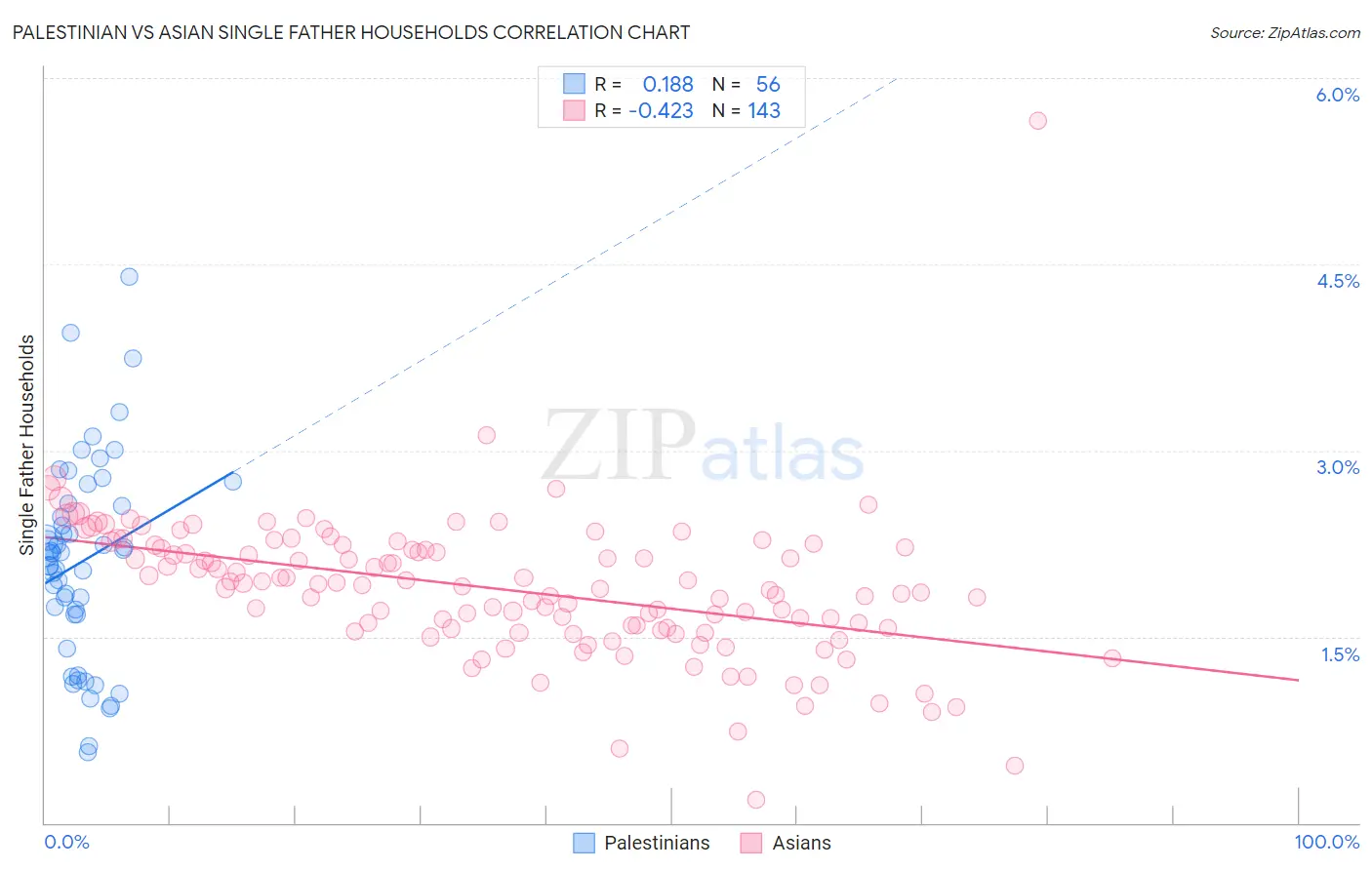Palestinian vs Asian Single Father Households
COMPARE
Palestinian
Asian
Single Father Households
Single Father Households Comparison
Palestinians
Asians
2.2%
SINGLE FATHER HOUSEHOLDS
98.6/ 100
METRIC RATING
105th/ 347
METRIC RANK
2.1%
SINGLE FATHER HOUSEHOLDS
99.6/ 100
METRIC RATING
86th/ 347
METRIC RANK
Palestinian vs Asian Single Father Households Correlation Chart
The statistical analysis conducted on geographies consisting of 215,869,880 people shows a poor positive correlation between the proportion of Palestinians and percentage of single father households in the United States with a correlation coefficient (R) of 0.188 and weighted average of 2.2%. Similarly, the statistical analysis conducted on geographies consisting of 539,811,945 people shows a moderate negative correlation between the proportion of Asians and percentage of single father households in the United States with a correlation coefficient (R) of -0.423 and weighted average of 2.1%, a difference of 2.6%.

Single Father Households Correlation Summary
| Measurement | Palestinian | Asian |
| Minimum | 0.57% | 0.19% |
| Maximum | 4.4% | 5.7% |
| Range | 3.8% | 5.5% |
| Mean | 2.1% | 1.9% |
| Median | 2.2% | 1.9% |
| Interquartile 25% (IQ1) | 1.7% | 1.6% |
| Interquartile 75% (IQ3) | 2.6% | 2.2% |
| Interquartile Range (IQR) | 0.88% | 0.67% |
| Standard Deviation (Sample) | 0.81% | 0.58% |
| Standard Deviation (Population) | 0.80% | 0.58% |
Demographics Similar to Palestinians and Asians by Single Father Households
In terms of single father households, the demographic groups most similar to Palestinians are Alsatian (2.1%, a difference of 0.37%), Lebanese (2.1%, a difference of 0.39%), Argentinean (2.1%, a difference of 0.41%), Immigrants from Western Europe (2.1%, a difference of 0.44%), and Immigrants from Northern Africa (2.1%, a difference of 0.59%). Similarly, the demographic groups most similar to Asians are Immigrants from Hungary (2.1%, a difference of 0.080%), Lithuanian (2.1%, a difference of 0.51%), Bhutanese (2.1%, a difference of 0.64%), Immigrants from Armenia (2.1%, a difference of 0.69%), and Immigrants from Pakistan (2.1%, a difference of 0.70%).
| Demographics | Rating | Rank | Single Father Households |
| Immigrants | Hungary | 99.6 /100 | #85 | Exceptional 2.1% |
| Asians | 99.6 /100 | #86 | Exceptional 2.1% |
| Lithuanians | 99.5 /100 | #87 | Exceptional 2.1% |
| Bhutanese | 99.5 /100 | #88 | Exceptional 2.1% |
| Immigrants | Armenia | 99.5 /100 | #89 | Exceptional 2.1% |
| Immigrants | Pakistan | 99.5 /100 | #90 | Exceptional 2.1% |
| Immigrants | Guyana | 99.4 /100 | #91 | Exceptional 2.1% |
| Romanians | 99.4 /100 | #92 | Exceptional 2.1% |
| Croatians | 99.3 /100 | #93 | Exceptional 2.1% |
| Ukrainians | 99.3 /100 | #94 | Exceptional 2.1% |
| Bermudans | 99.2 /100 | #95 | Exceptional 2.1% |
| Arabs | 99.2 /100 | #96 | Exceptional 2.1% |
| Immigrants | Moldova | 99.1 /100 | #97 | Exceptional 2.1% |
| Guyanese | 99.1 /100 | #98 | Exceptional 2.1% |
| South Africans | 99.1 /100 | #99 | Exceptional 2.1% |
| Immigrants | Northern Africa | 99.0 /100 | #100 | Exceptional 2.1% |
| Immigrants | Western Europe | 98.9 /100 | #101 | Exceptional 2.1% |
| Argentineans | 98.9 /100 | #102 | Exceptional 2.1% |
| Lebanese | 98.9 /100 | #103 | Exceptional 2.1% |
| Alsatians | 98.9 /100 | #104 | Exceptional 2.1% |
| Palestinians | 98.6 /100 | #105 | Exceptional 2.2% |